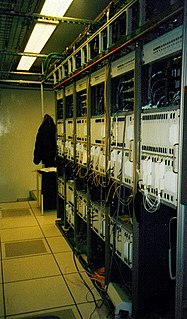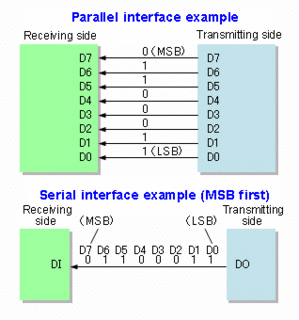External links
| This computing article is a stub. You can help Wikipedia by expanding it. |
SPI-4.2 is a version of the System Packet Interface published by the Optical Internetworking Forum. It was designed to be used in systems that support OC-192 SONET interfaces and is sometimes used in 10 Gigabit Ethernet based systems.
SPI-4 is an interface for packet and cell transfer between a physical layer (PHY) device and a link layer device, for aggregate bandwidths of OC-192 Asynchronous Transfer Mode and Packet over SONET/SDH (POS), as well as 10 Gigabit Ethernet applications.
SPI-4 has two types of transfers—Data when the RCTL signal is deasserted; Control when the RCTL signal is asserted. The transmit and receive data paths include, respectively, (TDCLK, TDAT[15:0],TCTL) and (RDCLK, RDAT[15:0], RCTL). The transmit and receive FIFO status channels include (TSCLK, TSTAT[1:0]) and (RSCLK, RSTAT[1:0]) respectively.
A typical application of SPI-4.2 is to connect a framer device to a network processor. It has been widely adopted by the high speed networking marketplace.
The interface consists of (per direction):
The clocking is source-synchronous and operates around 700 MHz. Implementations of SPI-4.2 have been produced which allow somewhat higher clock rates. This is important when overhead bytes are added to incoming packets.
PMC-Sierra made the original OIF contribution for SPI-4.2. That contribution was based on the PL-4 specification that was developed by PMC-Sierra in conjunction with the SATURN Development Group.
The physical layer of SPI-4.2 is very similar to the HyperTransport 1.x interface, although the logical layers are very different.
| This computing article is a stub. You can help Wikipedia by expanding it. |

Synchronous optical networking (SONET) and synchronous digital hierarchy (SDH) are standardized protocols that transfer multiple digital bit streams synchronously over optical fiber using lasers or highly coherent light from light-emitting diodes (LEDs). At low transmission rates data can also be transferred via an electrical interface. The method was developed to replace the plesiochronous digital hierarchy (PDH) system for transporting large amounts of telephone calls and data traffic over the same fiber without the problems of synchronization.

In telecommunication and data transmission, serial communication is the process of sending data one bit at a time, sequentially, over a communication channel or computer bus. This is in contrast to parallel communication, where several bits are sent as a whole, on a link with several parallel channels.

A network interface controller is a computer hardware component that connects a computer to a computer network.
Packet over SONET/SDH, abbreviated POS, is a communications protocol for transmitting packets in the form of the Point to Point Protocol (PPP) over SDH or SONET, which are both standard protocols for communicating digital information using lasers or light emitting diodes (LEDs) over optical fibre at high line rates. POS is defined by RFC 2615 as PPP over SONET/SDH. PPP is the Point to Point Protocol that was designed as a standard method of communicating over point-to-point links. Since SONET/SDH uses point-to-point circuits, PPP is well suited for use over these links. Scrambling is performed during insertion of the PPP packets into the SONET/SDH frame to solve various security attacks including denial-of-service attacks and the imitation of SONET/SDH alarms. This modification was justified as cost-effective because the scrambling algorithm was already used by the standard used to transport ATM cells over SONET/SDH. However, scrambling can optionally be disabled to allow a node to be compatible with another node that uses the now obsoleted RFC 1619 version of Packet over SONET/SDH which lacks the scrambler.
In computer networking, a minimal pause may be required between network packets or network frames. This time between packets is known as the interpacket gap (IPG), interframe spacing, or interframe gap (IFG). Depending on the physical layer protocol or encoding used, the pause may be necessary to allow for receiver clock recovery, permitting the receiver to prepare for another packet or another purpose.
Gigapackets are billions (109) of packets or datagrams. The packet is the fundamental unit of information in computer networks.
The media-independent interface (MII) was originally defined as a standard interface to connect a Fast Ethernet media access control (MAC) block to a PHY chip. The MII is standardized by IEEE 802.3u and connects different types of PHYs to MACs. Being media independent means that different types of PHY devices for connecting to different media can be used without redesigning or replacing the MAC hardware. Thus any MAC may be used with any PHY, independent of the network signal transmission media.
The Optical Internetworking Forum (OIF) is a prominent non-profit consortium that was founded in 1998. It promotes the development and deployment of interoperable computer networking products and services through implementation agreements (IAs) for optical networking products and component technologies including SerDes devices.
The System Packet Interface (SPI) family of Interoperability Agreements from the Optical Internetworking Forum specify chip-to-chip, channelized, packet interfaces commonly used in synchronous optical networking and Ethernet applications. A typical application of such a packet level interface is between a framer or a MAC and a network processor. Another application of this interface might be between a packet processor ASIC and a traffic manager device.
PL-4 or POS-PHY Level 4 was the name of the interface that the interface SPI-4.2 is based on. It was proposed by PMC-Sierra to the Optical Internetworking Forum. The name means Packet Over SONET Physical layer level 4. PL-4 was developed by PMC-Sierra in conjunction with the Saturn Development Group.
PL-3 or POS-PHY Level 3 is a network protocol. It is the name of the interface that the Optical Internetworking Forum's SPI-3 Interoperability Agreement is based on. It was proposed by PMC-Sierra to the Optical Internetworking Forum and adopted in June 2000. The name means Packet Over SONET Physical layer level 3. PL-3 was developed by PMC-Sierra in conjunction with the SATURN Development Group.
SPI-3 or System Packet Interface Level 3 is the name of a chip-to-chip, channelized, packet interface widely used in high-speed communications devices. It was proposed by PMC-Sierra based on their PL-3 interface to the Optical Internetworking Forum and adopted in June 2000. PL-3 was developed by PMC-Sierra in conjunction with the SATURN Development Group.
The Physical Coding Sublayer (PCS) is a networking protocol sublayer in the Fast Ethernet, Gigabit Ethernet, and 10 Gigabit Ethernet standards. It resides at the top of the physical layer (PHY), and provides an interface between the Physical Medium Attachment (PMA) sublayer and the media-independent interface (MII). It is responsible for data encoding and decoding, scrambling and descrambling, alignment marker insertion and removal, block and symbol redistribution, and lane block synchronization and deskew.
A Serializer/Deserializer is a pair of functional blocks commonly used in high speed communications to compensate for limited input/output. These blocks convert data between serial data and parallel interfaces in each direction. The term "SerDes" generically refers to interfaces used in various technologies and applications. The primary use of a SerDes is to provide data transmission over a single line or a differential pair in order to minimize the number of I/O pins and interconnects.
Dynamic Packet Transport (DPT) is a Cisco transport protocol designed for use in optical fiber ring networks. In overview, it is quite similar to POS and DTM. It was one of the major influences on the Resilient Packet Ring/802.17 standard.
In data networking and transmission, 64b/66b is a line code that transforms 64-bit data to 66-bit line code to provide enough state changes to allow reasonable clock recovery and alignment of the data stream at the receiver. It was defined by the IEEE 802.3 working group as part of the IEEE 802.3ae-2002 amendment which introduced 10 Gbit/s Ethernet. At the time 64b/66b was deployed, it allowed 10 Gb Ethernet to be transmitted with the same lasers used by SONET OC-192, rather than requiring the 12.5 Gbit/s lasers that were not expected to be available for several years.
SerDes Framer Interface is a standard for telecommunications abbreviated as SFI. Variants include:

10 Gigabit Ethernet is a group of computer networking technologies for transmitting Ethernet frames at a rate of 10 gigabits per second. It was first defined by the IEEE 802.3ae-2002 standard. Unlike previous Ethernet standards, 10 Gigabit Ethernet defines only full-duplex point-to-point links which are generally connected by network switches; shared-medium CSMA/CD operation has not been carried over from the previous generations Ethernet standards so half-duplex operation and repeater hubs do not exist in 10GbE.
V-by-One HS is an electrical digital signaling standard that can run at faster speeds over inexpensive twisted-pair copper cables than Low-voltage differential signaling, or LVDS. It was originally developed by THine Electronics, Inc. in 2007 for high-definition televisions but since 2010 V-by-One HS has been widely adopted in various markets such as document processing, automotive infotainment systems, industrial cameras and machine vision, robotics and amusement equipments.
The Common Electrical I/O (CEI) refers to a series of influential Interoperability Agreements (IAs) that have been published by the Optical Internetworking Forum (OIF). CEI defines the electrical and jitter requirements for 3.125, 6, 11, 25-28, and 56 Gbit/s electrical interfaces.